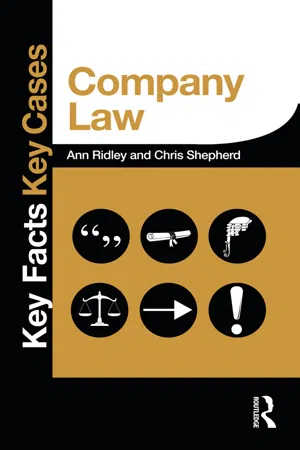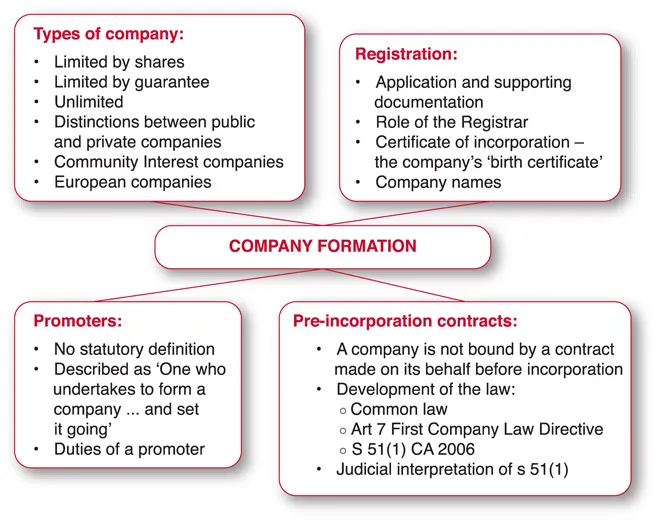
- 294 pages
- English
- ePUB (mobile friendly)
- Available on iOS & Android
Company Law
About This Book
Key Facts Key Cases Company Law will ensure you grasp the main concepts of your Company Law module with ease. This book explains the facts and associated case law for:
- Shares
- Capital Maintenance
- Failure and Liquidation
- Directors
- Borrowing
Ann Ridley is Interim Dean, Business and Management, Accounting and Law at The University of Gloucestershire.
Chris Shepherd is Lecturer in Law at London South Bank University.
Key Facts Key Cases is the essential series for anyone studying law at LLB, postgraduate and conversion courses. The series provides the simplest and most effective way to absorb and retain all of the material essential for passing your exams. Each chapter includes:
-
- diagrams at the start of chapters to summarise key points
-
- structured headings and numbered points to allow for clear recall of the essential points
-
- charts and tables to break down more complex information
Chapters are also supported by a Key Cases section which provides the simplest and most effective way to absorb and memorise essential cases needed for exam success.
-
- Essential and leading cases are explained
-
- The style, layout and explanations are user friendly
-
- Cases are broken down into key components by use of a clear system of symbols for quick and easy visual recognition
Series editors: Jacqueline Martin and Chris Turner LLM, who is Senior Lecturer in law at Wolverhampton University.
Frequently asked questions
1
Company formation

◗ 1.1 Types of company
- 1 A company may be created by registration of documents with the Registrar of Companies under the Companies Act (currently CA 2006), registration with another public official or body under another act (e.g. under the Charities Act 1993), by statute or by Royal Charter (the BBC is an example of the last of these). We are concerned only with the first method, that is, with ‘registered companies’.
- 2 Companies may be registered as follows:
- • Limited by shares. This is a company with a share capital divided into shares which are issued to members. The liability of members on a winding up is limited to any amount unpaid on the shares.
- • Limited by guarantee. Section 3(3) CA 2006 provides that in such a company the liability of members is limited to the amount they agree to contribute in the event of the company being wound up. Prior to the CA 1980, a company could be limited by guarantee with a share capital. However, although a few such companies still exist, this is no longer permitted by s 5(1) CA 2006.
- • Unlimited. A private company may be registered with unlimited liability, in which case the members will be liable to contribute to the whole of the company’s debts on liquidation. The main advantage of forming an unlimited company is that such companies are not subject to the disclosure requirements that apply to limited companies with respect to their accounts.
- 3 A major distinction is between public and private companies.
- • A public company is defined in s 4(2) CA 2006 as a company limited by shares (or by guarantee having a share capital) whose certificate of incorporation states that it is a public company in relation to which the requirements of the Act (or former Companies Acts) have been complied with.
- • Under s 761(1) CA 2006 a public company must not do business or exercise any borrowing powers unless the registrar is satisfied that the company has allotted shares with a nominal value of at least £50,000, of which 25 per cent must be paid up (the ‘authorised minimum’).
- • Under s 4(1) a private company is defined as any company that is not a public company. This is by far the most numerous type of company.
- • Both types of company may now be formed with one member: s 7(1) CA 2006.
- 4 A public company is subject to more stringent rules than a private company, especially in relation to disclosure, and throughout this book reference will be made to differences between public and private companies. Some of the more obvious differences are set out in the table below.
| Public companies | Private companies |
| Defined by s 4(2) CA 2006 | Defined by s 4(1) CA 2006 |
| Limited by shares or by guarantee having a share capital | May be limited by shares or by guarantee, or unlimited |
| Minimum share capital requirements: ss 761, 763 CA 2006 | No minimum share capital requirement |
| Designated by ‘plc’ or Welsh equivalent | If limited, must include ‘Limited’ or ‘Ltd’ after name |
| Shares may be offered to the public | Shares may not be offered to the public |
- 5 Community interest companies (CICs) were initially created by the Companies (Audit Investigations and Community Enterprise) Act 2004 for people who wanted to create social enterprises. The community interest company is recognised in s 6 CA 2006. The objects of such a company must show the intention to benefit the community and the directors must produce an annual report to show what the company has done for the benefit of the community. Community interest companies do not have charitable status, but do enjoy lighter regulation than other companies.
- 6 European Companies: Regulation (EC) No 2157/2001 made it possible, from October 2004, to create a European public limited company, or Societas Europaea, where there is co-operation between at least two different companies in different member states.
- 7 The Limited Liability Partnership Act 2000 allows for incorporation by registration of a limited liability partnership (LLP). An LLP is a corporate body with a separate legal personality, while the relationship between the partners is the same as in a partnership. An LLP may only be formed for ‘carrying on a lawful business with a view to profit’. Whereas an LLP must be for profit, a company can be registered for non-business purposes.
◗ 1.2 Registration
1.2.1 Documentation under the Companies Act 2006
- 1 All companies must be registered by Companies House, a government agency (for more information see www.companieshouse.gov.uk). To incorporate a company it is necessary to deliver an application together with the necessary documents to the Registrar of Companies for England and Wales or, for a company to be registered in Scotland, the Registrar of Companies for Scotland: s 9 CA 2006.
- 2 Electronic incorporation has been possible for certain users, mainly company formation agents, since 2001 and for individual users since 2007.
- 3 The application must contain the following information:
- • the company’s proposed name;
- • the part of the United Kingdom where it is to be registered – whether in England and Wales, Scotland or Northern Ireland;
- • whether the members are to have limited liability and, if so, whether by shares or by guarantee;
- • whether the company is to be ...
Table of contents
- Cover
- Half Title
- Title
- Copyright
- Contents
- PREFACE
- TABLE OF CASES
- Chapter 1 COMPANY FORMATION
- Chapter 2 CORPORATE PERSONALITY
- Chapter 3 THE CONSTITUTION
- Chapter 4 TRANSACTIONS WITH OUTSIDERS
- Chapter 5 SHARE CAPITAL
- Chapter 6 MAINTENANCE OF CAPITAL
- Chapter 7 COMPANY BORROWING
- Chapter 8 MEETINGS AND RESOLUTIONS
- Chapter 9 DIRECTORS
- Chapter 10 DIRECTORS’ DUTIES
- Chapter 11 SHAREHOLDER REMEDIES
- Chapter 12 COMPANY FAILURE AND LIQUIDATION
- INDEX